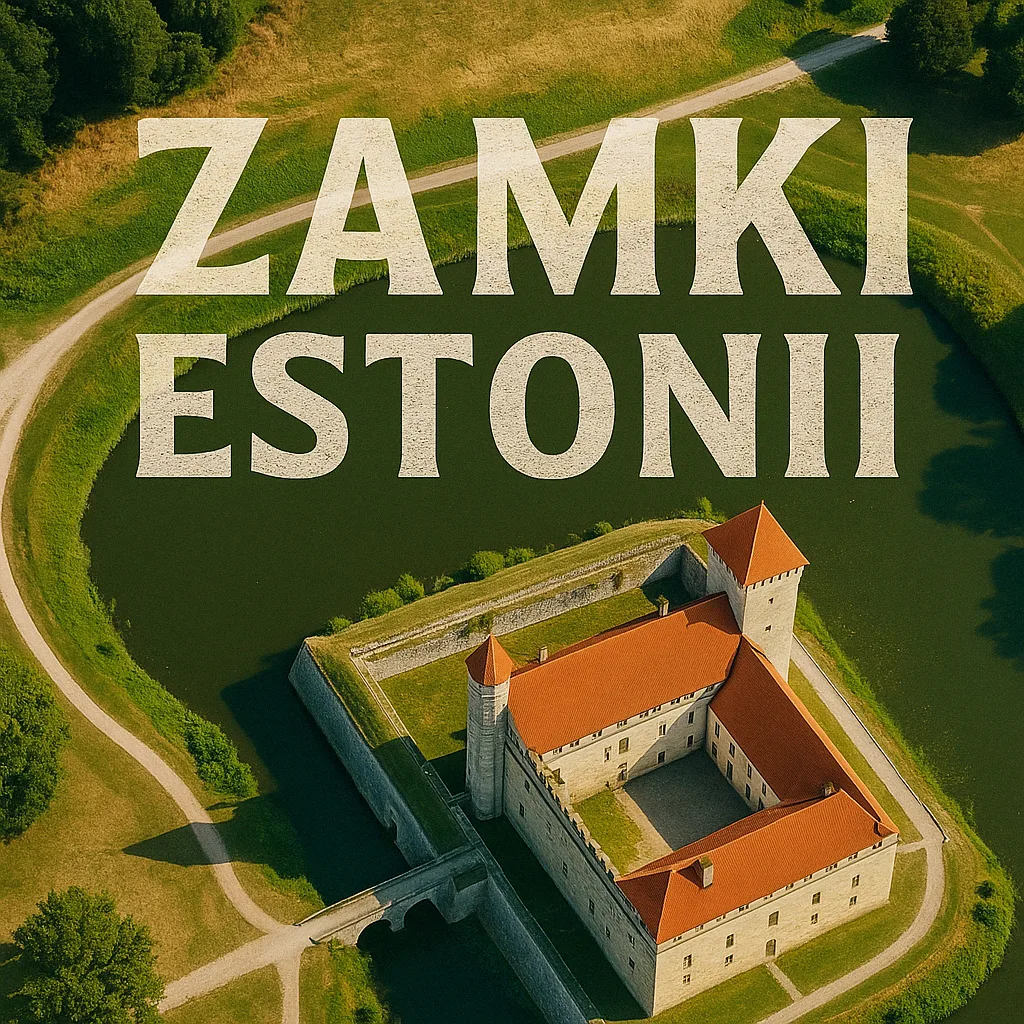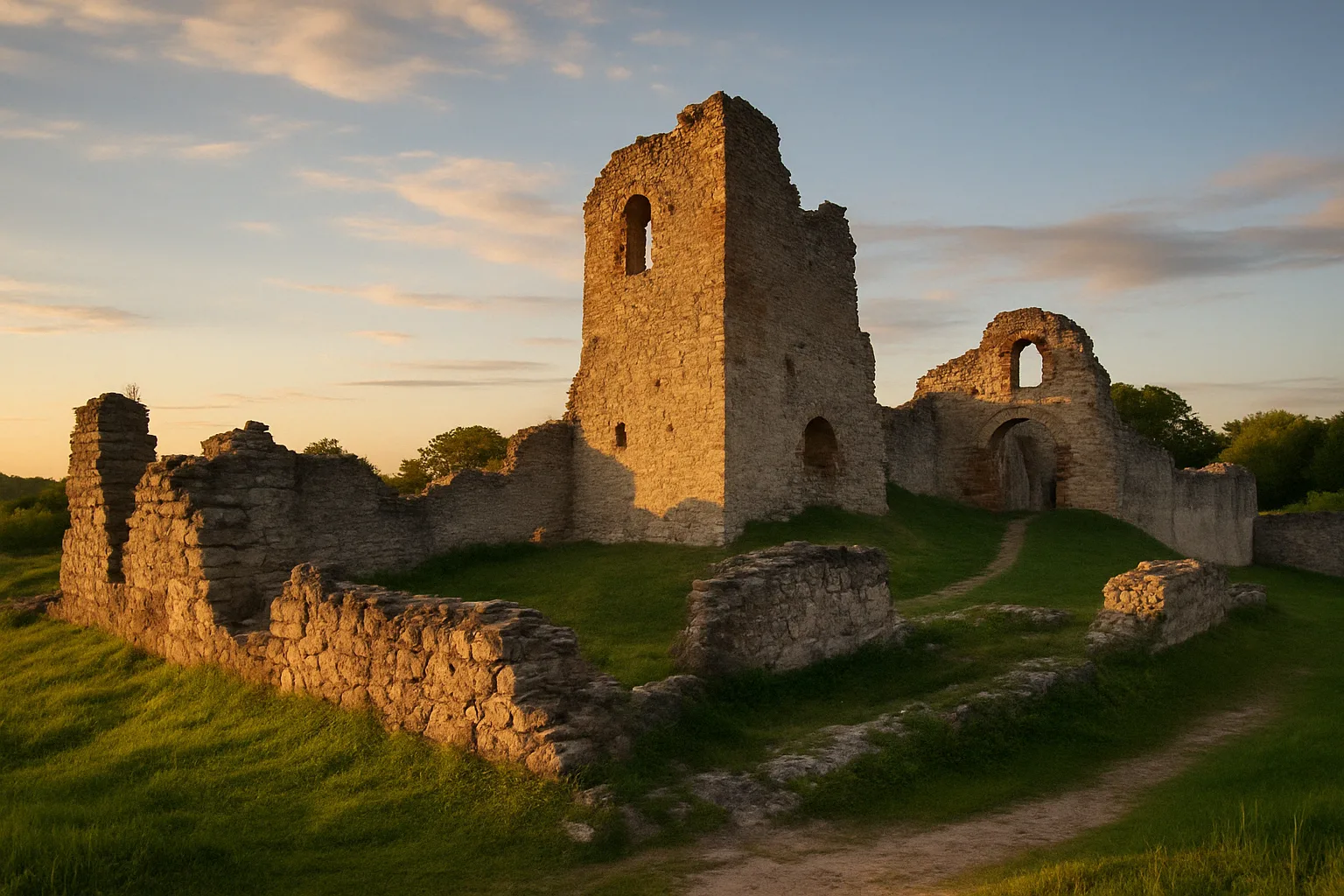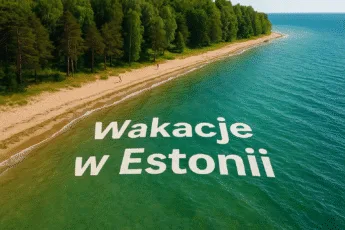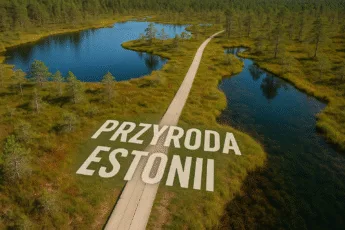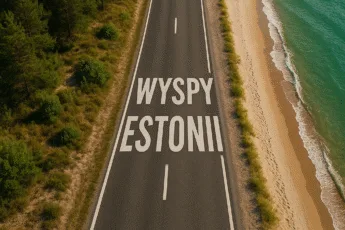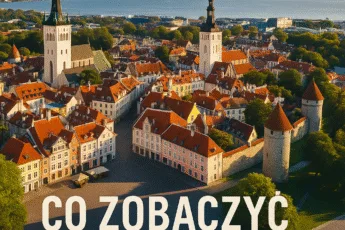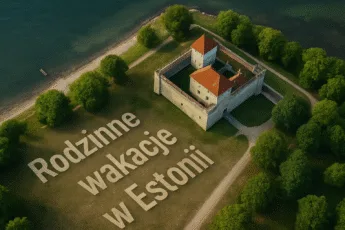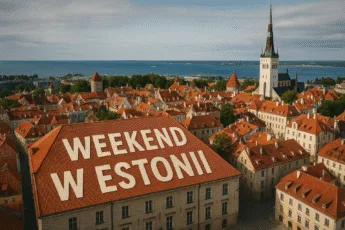The journey through Estonian castles and noble palaces is not only a history lesson, but also a unique aesthetic experience. Each of these facilities has its own character - from strict fortresses on the border with Russia to elegant residences surrounded by national parks. Although Estonia is mainly associated with nature and silence on the Baltic Sea, it is also worth looking at its tourist potential - you will find full context in the main analysis of the holidays in Estonia 2025 .
Castles in Estonia are souvenirs of the medieval - Teutonic, episcopal and Livonian times. Many of them retained their walls, towers and courtyards, giving the opportunity to authentic contact with history. In turn, Estonian palaces delight with harmony and style - baroque, classicism or romanticism perfectly fit into the landscape of northern Europe. Some of them have been renovated and have museum or hotel functions today.
In this guide you will find both the most interesting Estonian castles and unique palaces in Estonia , which are worth visiting during a vacation or short trip. Each description is a portion of proven information: from history to opening hours, from curiosities to route proposals. If you are looking for a trip with context and soul - you are in the right place.
Why is it worth visiting castles and palaces in Estonia?
Castles in Estonia are not only traces of medieval orders and princes, but specific points on the map that allow you to understand how power, religion and culture in today's Baltic State were shaped. In turn, palaces in Estonia show the aspirations and lifestyle of the Estonian nobility, German barons and Russian elites. Their diversity and authenticity make Estonia stand out from the region - not with the quantity, but with the quality of preserved residences and fortresses.
A short history of Estonian defense architecture
The construction of castles in today's Estonia began intensively after 1227, when the region was conquered by the Order of Sword Knights and later the Teutonic Knights. The first stone fortresses were created then - Topea in Tallinn (1230), Hermann in Narv (1256), Kuressaare on the island of Saaremaa (14th century). The castles had a military and also administrative function - they were the seat of religious and episcopal authorities. In the 16th -18th centuries, many fortresses were rebuilt by the Swedes and Russians, and from the 18th century they ceased to perform defensive functions.
Palaces and castles as a cultural heritage
While the castles were created mainly in a religious and military context, the palaces began to be built intensively only in the 18th century-most often as the residences of the Baltic nobility, mainly German origin. The baroque style is represented by Kadriorg (1725), Classicism - Palmse (nineteenth century), Romanticism - Alatskivi (end of the 19th century). In the Soviet era, many facilities have been devastated or turned into state centers. Currently, part of the residence has been restored and serves as museums, hotels or conference centers.
| Type of object | Era of uprising | Architectural style | Contemporary function |
|---|---|---|---|
| Topea lock | approx. 1230 | Gothic / Classicism | The seat of the Estonia Parliament |
| Kuressaare Castle | approx. 1380 | Gothic | Regional Museum |
| Kadriorg Palace | 1725 | Baroque | Museum of Art |
| ALATSKIVI Palace | 1885–1890 | Scottish romanticism | Museum + Restaurant |
- The castles had a defensive, religious and administrative function.
- Palaces were cultural, education and social national team centers.
- Many of them regained the status of national monuments after 1991.
- Currently, some facilities operate as public or commercial institutions (museums, hotels).
Castle in Tallinn (Topea) - the heart of Estonian history
Topea Castle is not only a symbol of Tallinn, but also one of the most important places in the history of Estonia. Built on a limestone hill, from the 13th century he served as a political and administrative center of the country. Today it is the seat of the Estonian parliament - the Riigikog - and at the same time a must for anyone who wants to understand how modern Estonian statehood was born.
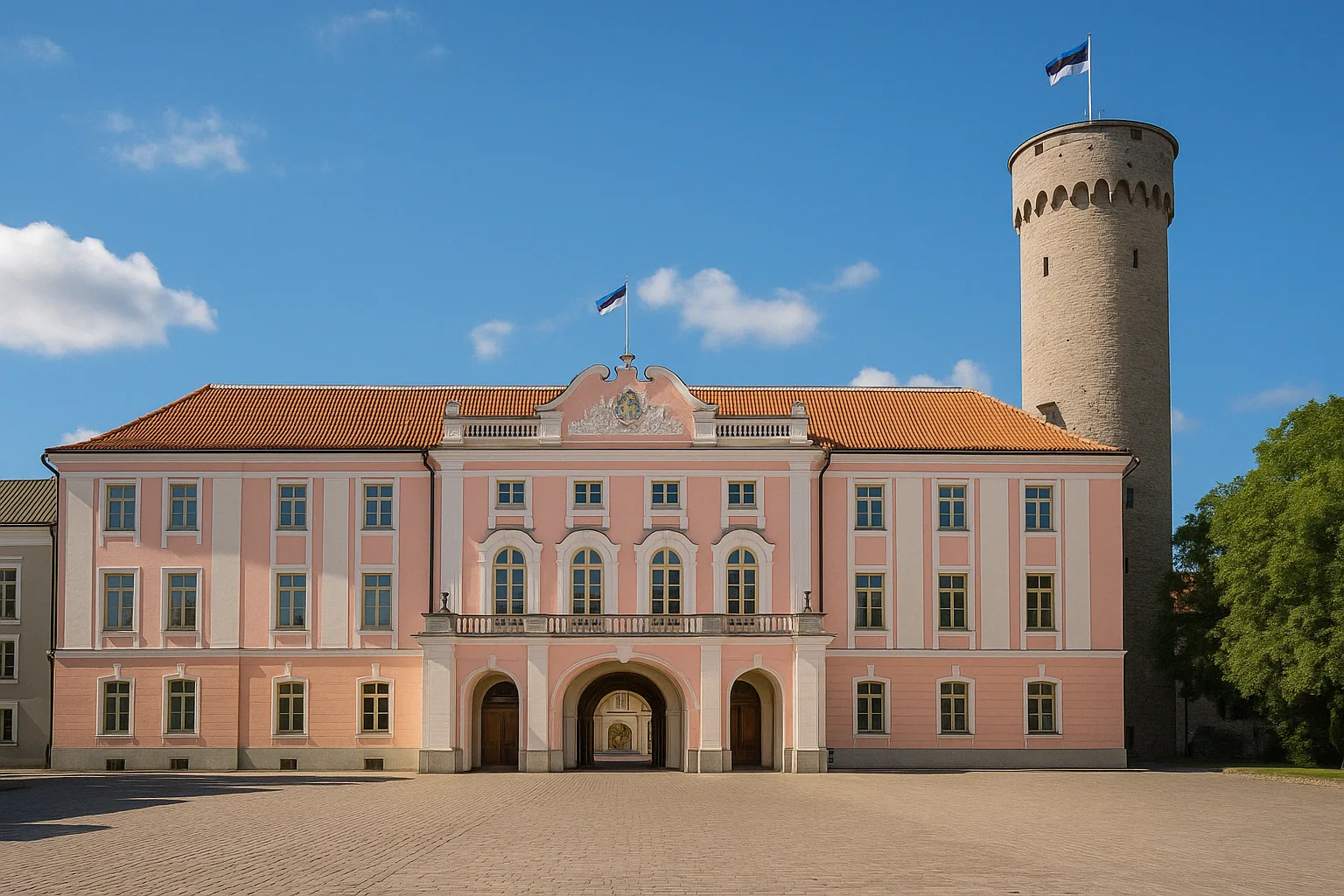
What is worth knowing about Topea?
The Topea Hill (German: Domberg) from the 12th century was a strategic place in Tallinn. After the conquest through the Order of Sword Knights in 1227, the construction of the first defensive structures began. For centuries, the castle changed the owners - from religious, through the Danes, the Swedes to the Russians. He obtained its current appearance mainly in the 18th century, when a classicist facade with a column portico was created - today recognizable from every Tallinn postcard. The castle has, among others Herman Tower (Pikk Hermann), from which every day at 7:00 the anthem of Estonia resounds - symbolically starting the state day.
What attractions does the castle offer today?
Although topea is not a typical castle museum, part of its interiors is available to visitors. You can enter the courtyard, see the parliament's facade and take a walk on the walls with a view of the lower city. On certain days, free sightseeing with a guide take place, and thematic visits are possible for groups - after prior booking. Nearby there is also the Council of Aleksander Nevsky and the Kohtuots viewpoint, from where there is a panorama of Tallinn.
| Type of sightseeing | Days and hours | Fees | Availability of a guide |
|---|---|---|---|
| Courtyard and facade | daily, 8: 00–22: 00 | free | not applicable |
| Visiting parliament | Mon -pt., Official hours | free of charge (booking) | Yes (Ang./Est.) |
| Entrance to the Hermann Pikk Tower | seasonally (May -September) | free | with an employee of the Riigikogu |
- From the Tower of Pikk Hermann every day at 7:00 the anthem of Estonia is played.
- Parliament facade in the classical style dates from 1773.
- The Topea Hill has its own administrative history - it has been a separate city organism for centuries.
- Visiting the interior of the parliament requires prior online registration.
See also: The most interesting places in Estonia outside Tallinn
Herman Castle in Narv - the guardian of the border
Herman's castle is the best preserved medieval fortress in eastern Estonia and the only monument in Europe, which is literally opposite the Russian fortress. Separated only by the 150-meter section of the Narwy River, two castles-Estonian and Russian-symbolically and literally designate the cultural, historical and geopolitical border. For tourists it is one of the most unusual places in North-Eastern Europe.

Castle with a view of Russia
The first mention of Herman's castle comes from the end of the 13th century, when the Teutonic Knights began the construction of a brick watchtower over Narva. In 1347, the Teutonic Order took control of the whole Narva and expanded the object to the size of a full -fledged fortress. Herman's high tower (Hermann Pikk, 51 meters) served as a guard with a view of the east bank of the river. On the other side, from 1492, there is a Russian Iwangorod Fortress, built on the order of Ivan III. Since then, both strongholds have been functioning as an architectural "mirror reflections" of two worlds: Latin-European and Orthodox-East.
A fortress that has survived ages
Herman's castle played a key role during the Swedish-Russian wars, as well as during World War I and II. Although heavily damaged in 1944, it was rebuilt in 1950–1962 and today it is open to visitors. Inside, there is a regional museum with exhibitions on the history of borderland, military and Estonian-Russian culture. From the walls and the tower there is a view of the Iwangorod Fortress and the Border Bridge. This is one of the few places where you can physically stand "face to face" with another culture - without crossing the border.
| Comparison element | Herman's castle (Estonia) | Iwangorod Fortress (Russia) |
|---|---|---|
| Date of foundation | approx. 1300 | 1492 |
| Architectural style | Gothic / religious style | Moscow Defense Renaissance |
| The height of the main tower | 51 m (Hermann Pikk) | approx. 50 m |
| Function today | Museum, viewpoint | Not available to tourists (2024) |
- This is the only place in Europe where two fortresses from different eras and cultures stand opposite each other.
- Visiting the Pikk Hermann tower allows you to see Russia without crossing the border.
- Historical events and military shows take place in the courtyard.
- The museum offers audio guides in Estonian, Russian and English.
See also: How to plan a weekend trip to Narwy
Rakvere Castle - medieval amusement park
Rakvere Castle is one of the few places in northeastern Europe, where the medieval fortress was transformed into an interactive educational and entertainment complex. A 90 km east of Tallinn attracts not only history lovers, but also families with children who can touch, taste and experience the realities of the 15th century - without screens and filters. This is an example of a modern approach to heritage that does not lose authenticity.

Interactive sightseeing for the whole family
The castle in Rakvere was built around 1250 on the Vallimägi Hill - a place of strategic significance already in pagan times. The current form comes mainly from the time of Danish and Livonian rule (XIII -XIV century). In the 21st century, the castle was transformed into a "live museum". The tour includes, among others Armory, an alchemical basement, a torture room, a forge, as well as a tournament square and a medieval kitchen. Employees in era costumes conduct knight's fighting shows, craft workshops and educational classes - all in accordance with historical facts and without embellishments.
What was life in the fortress like?
Everyday life in the Rakvere castle was recreated on the basis of archaeological research and written sources. Visitors can check how heavy knightly armor (20-30 kg) was, how hygiene looked like (i.e. the lack of it), and how the penalty system functioned - from flogging to public ridicule. Medieval medical theories are presented in the alchemical basement, while dishes are prepared in the kitchen according to the original recipes from the era. Children can take part in the training of squire, and adults try on chainmarks and tighten the crossbow. All within one ticket, without hidden fees.
| Attraction | For whom | Availability | Comments |
|---|---|---|---|
| Knightly tournament | Adults and children | SOD -Sun, at 13:00 and 16:00 | Included in the ticket price |
| Craft workshops | Children 6-12 years | daily, 11: 00–15: 00 | No reservation |
| Alchemist trail | Adults | individually | with an audio guide |
| Admission tickets | – | daily, 10: 00-18: 00 | 12 € adults / € 8 children |
- The only torture room in Estonia is available to visitors with an auditory of medieval methods.
- Possibility of shooting with crossbow and exercises in armor (for people over 14 years of age).
- Theater shows with the participation of reconstructors every holiday weekend.
- There is a historic tavern serving dishes according to 15th-century recipes.
Kuressaare Castle - the pearl of the Saarema island
Kuressaare Castle is the best preserved medieval castle in Estonia and one of the main attractions of the Saaremaa island. Located on the Baltic Sea, away from large cities, it is a unique combination of history, nature and defense architecture. Thanks to the perfect behavior and high level of museum exhibition, the castle attracts tourists from all over Europe.
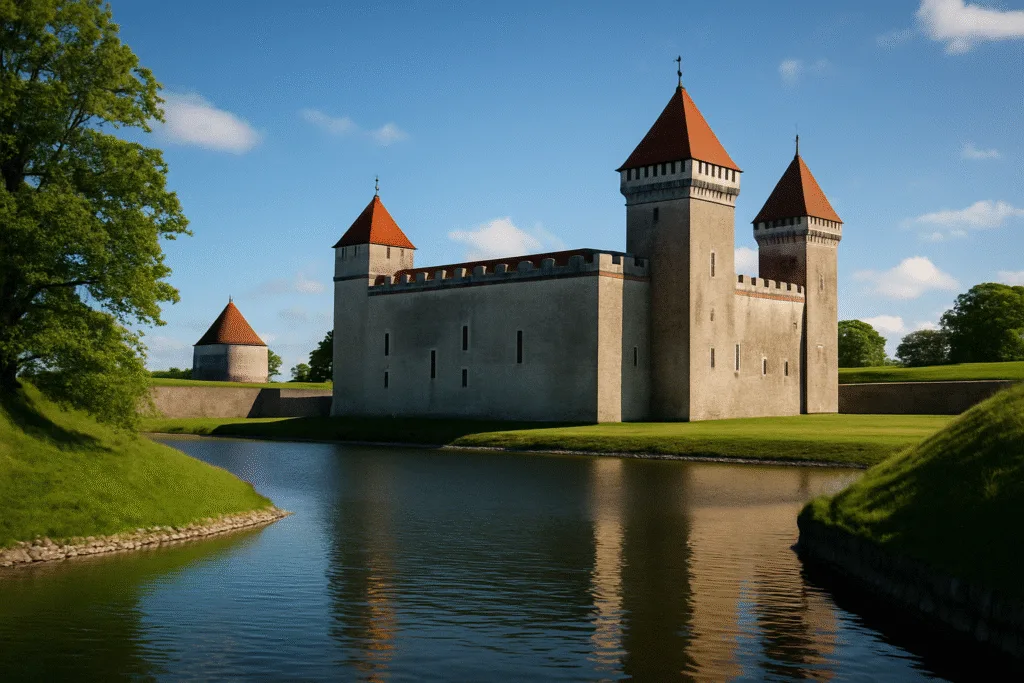
The perfect combination of nature and history
The bishop's castle in Kuressaare was created in the second half of the fourteenth century and has maintained an almost unchanged arrangement and elements of original constructions to this day. Located on the coast, overlooking the bay, he served as the center of church and defensive authorities in the western part of the island of Saaremaa. A massive building with an internal courtyard, high walls and a moat also retained elements of the defense system - a drawbridge, shooting ranges, patrol cloisters. The castle surrounding the castle Park smoothly passes to the waist of the coast and the promenade, which makes this place unique in terms of landscape.
Museum and fortifications worth visiting
The castle operates an extensive Saaremaa Museum , whose exhibitions present the history of the island from pagan times, through Danish, Swedish and Russian reign, to the 20th century. We will also find here ethnographic, archaeological and military exhibitions, including Reconstructions, armor, courtroom and castle mockups from various eras. Particularly interesting is the route on the defensive walls - available without a guide, with a view of the city of Kuressaare and the Baltic. In the summer, concerts, archery tournaments and educational workshops for children are organized.
| Practical element | Details |
|---|---|
| Access | Virtu ferry to Kuivast + 80 km by road No. 10 (approx. 2 hours) |
| Opening hours | May -September: daily 10: 00–19: 00; out of season: 11: 00-17: 00 |
| Ticket prices | Adults: 12 €, children: 7 €, family: € 25 |
| Visiting with a guide | In Estonian, English and Finnish (reservation required) |
- The Walking Seaside Promenade connects the castle with the city beach and the Health Park.
- There are 38 windmills on the island - the largest cluster of historical windmills in Estonia.
- In the vicinity of Kuressaare there are mineral and SPA sources - popular in the 19th century.
- It is also worth visiting the Sõrve lantern and the Vilsandi reserve.
See also: Where to relax on the beach during your stay at Saaremaa
Haapsal's castle - the legend and the Spirit of the White Lady
The castle in Haapsal is one of the best preserved Gothic defensive assumptions in Estonia and the only castle in the country that has been functioning as the seat of the bishopric for centuries. Known for a powerful chapel, high walls and a mysterious legend about the White Lady, it attracts tourists not only with architecture, but also with an atmosphere. An additional advantage is its location - only 300 meters from the Baltic Bay.
Gothic history in a coastal climate
The castle in Haapsal was created around 1260 as a residence of the Bishop of the Ösel. Massive stone walls, towers and vaults of the cathedral chapel represent pure Inflanian Gothic. The sacred part of the castle - Domus Cathedralis - is the largest one -nave medieval building in the region. For centuries, the castle was the center of religious life of Western Estonia, as well as a place of exit and diplomatic meetings. In the nineteenth century he fell into ruin, but from 1930 its renovation was underway. Today, it is made available in the form of a museum with a modern multimedia exhibition, an observation tower and an interactive room for children.
White Lady and her mysterious story
The White Lady legend (Valge Daam) is one of the most famous folk stories in Estonia. According to the messages, a young woman fell in love with a monk and secretly lived in the castle, which was contrary to the rules of religious severity. When their relationship was discovered, the priest was lost, and the woman - walled up alive in the wall of the chapel. From now on, her spirit is to appear in the southern window during the full August moon. Just then, in mid -August, a special festival on legend takes place in Haapsal - with concerts, performances and illuminations. This event attracts several thousand visitors every year.
| Event | Date | Character | Comments |
|---|---|---|---|
| White Lady Festival | middle of August | Concerts, theater, 3D mapping | free admission to the courtyard |
| Museum Night | May (Saturday) | night tour + guides | free of charge, mandatory entries |
| Summer outdoor cinema | July -August (Fri - Sob.) | Historical and fantasy movies | included in the price of the castle ticket |
| Medieval market | June | Craft, kitchen, music | Organized since 2005 |
- August is the best time to visit - then you can see the window of the White Lady in full illumination.
- An audio guide in 4 languages is available on site, also in Polish.
- The castle viewpoint allows you to observe the shoreline and sunsets.
- For children, the "Searching for Spirit" - educational escape room in the tower was prepared.
Põltsamaa Castle - from ruins to reconstruction
Põltsamaa Castle , although it remained in ruins for decades, today undergoes dynamic revitalization and becomes one of the most interesting examples of a modern approach to historical heritage in Estonia. Located in the center of the country, just above the river with the same name, the facility gradually regains its function - as a local center of culture, art and tourism.

Ruins with potential
The history of the castle dates back to 1272, when the Order of Sword Knights raised the first fortress here. In the following centuries, the castle passed into the hands of the kingdom of Denmark, Sweden and Russia, acting as a military object, and later - a baroque residence. In 1941 he was destroyed by a fire during World War II and remained partly ruined for decades. Despite this, his plan behaved extremely well: a four -sided courtyard, gate and towers system, as well as traces of baroque cloisters allow to recreate the original arrangement of buildings with great precision. Since 2016, the castle has been the subject of a long -term reconstruction program supported by local authorities and the Ministry of Culture of Estonia.
A modern cultural center in the castle walls
Thanks to the gradual renovation and commitment of the local community, the Põltsamaa castle changes its status from the "see you from outside" to a full -fledged place of cultural events. The art gallery, a modern regional museum, a conference room and a tourist information center currently operates in the rebuilt part. From 2022, an interactive multimedia exhibition was also launched, dedicated to the history of the JõGevamaa region. Concerts and fairs are held regularly in the courtyard. Investments go hand in hand with respect for the historic substance - most of the works are carried out by conservation methods, without interfering with the historic layout of the walls.
| STAGE / ELEMENT OF THE PROJECT | Status | Financing | Planned ending |
|---|---|---|---|
| Reconstruction of external walls | Completed (2021) | EU funds + city | – |
| New Regional Museum | open (2022) | state budget | – |
| Restoration of southern cloisters | in implementation | "Kulturipärand 2024" program | End 2025 |
| New summer scene + infrastructure | planned | Private and public partnership | 2026 |
- The castle is located 130 km from Tallinn - easily available by road No. 38.
- This is one of the few places in Estonia, where the ruin turns into an active art center.
- There is also a winery on the premises - with a tradition dating back to 1920.
- Since 2023, a bicycle and kayak rental point has also been operating at the castle.
Laiuse Castle - an abandoned fortress of the Livonian Order
Laiuse Castle is one of the least known, and at the same time the most authentic places related to the history of the Livonian Order in Estonia. Located away from the main tourist routes, between JõGeva and Tartu, it retained the harsh atmosphere of the former border fortress. The ruins, although partly overgrown, still show the distribution of medieval fortifications and are a great starting point for pedestrian routes on the historic border.
Strategic significance in the history of the region
The fortress in Laiuse was erected by the Livonian Order around 1370, as a extended border institution on the Estonian-Russian border. The castle served as a defensive function until the 17th century, serving as a contact point and a place of concentration of troops during the Inflanian wars. After the takeover of the region by the Swedes in 1622, he was transformed into a residence of the military command, and later - into a palace with Renaissance elements. Final destruction took place during the Great Northern War (1700-1721), after which the castle was no longer rebuilt. His current state is the result of over 300 years of natural erosion - without reconstruction, but also without excess tourist interference.
How to explore the ruins without a guide?
Access to the castle is possible from road No. 36 - the nearest town is Laiusevälja. The ruins are available around the clock and are not fenced or monitored. Admission is free, there is no ticket office or guides - an ideal option for independent travelers. It is worth having solid footwear with you - some of the stairs and passes have not been secured. The circular route is recommended: we start sightseeing from the main gate, go through the remains of the Main Hall and the northern walls, and then climb the embankment from the south. The lack of crowds and noise makes the place a unique atmosphere - perfect for a reflective walk or landscape photography.
| Route | Length | Terrain | Transition time |
|---|---|---|---|
| Laiuse - castle ruins - southern hill | 1.5 km | meadows, unpaved paths | ~ 30 minutes |
| Loop around the castle + viewpoint | 2.1 km | mixed: grass, pavement, debris | ~ 45 minutes |
| Historical walk to the former cemetery | 1 km (one way) | paved trail | ~ 25 minutes |
- The southern hill offers the best view of the castle outline and surrounding fields.
- In the summer season it is worth planning a visit to sunset - the light emphasizes the structure of the walls.
- There is no infrastructure nearby - it is worth buying water and an offline map in advance.
- The area is not guarded - caution, especially in the rain.
Kadriorg Palace - Baroque residence in Tallinn
Kadriorg Palace is the most important residential monument of Estonia and the only baroque building of this type in the country. Established on the initiative of Piotr I, it is surrounded by a vast park with fountains, pavilions and museums. It is a place where the history of tsarist power meets with art, nature and city lifestyle Tallinn.

The gift of Piotr the Great for Tsarina Katarzyna
The construction of the Kadriorg Palace began in 1718, shortly after the Estonia was incorporated into the Russian Empire as a result of the Northern War. Tsar Piotr and personally chose the location of the residence, located in the south -east of Tallinn, away from the Citadel and the Port of War. The palace was to be a gift for Katarzyna and the first place of rest away from the St. Petersburg court. The project was prepared by the Italian architect Nicola Michetti, and the implementation was supervised by Gaetano Chiaveri. The main wing of the building was completed in 1725 - in the year of Piotr's death. The palace was used by the tsarist family sporadically, but became a model for residential architecture throughout the Baltic region.
Today: Art Museum and National Park
From 1921, the Palace has been operating the Museum of Art, and from 2000 - its modern kumu wing. The collections include works of Russian, Western European and Estonian painting from the 18th to the 21st century. The palace interiors have been recreated in accordance with the archival documentation - you can see, among others Ballroom, porcelain room and imperial apartments. In the park surrounding the residence (over 70 ha) there are pavilions, ponds, Japanese gardens and the classicist Palace of Mikkeli. The whole is covered by conservation protection as a Kadrior Park complex. In 2023, this place was visited by over 400,000 people.
| Exhibition / object | Location | Opening hours | Admission ticket |
|---|---|---|---|
| Kadriorg Palace - historical interiors | main wing | Tue - Ndz., 10: 00-18: 00 | € 10 /6 € reduced |
| Mikkeli Museum | garden pavilion | Wedded - NDZ., 10: 00–17: 00 | 6 € |
| Kumu - modern art | Eastern end of the park | Tue - Sun, 10: 00-18: 00 | 12 € / 8 € reduced |
- The main baroque fountain in the courtyard operates from May to September.
- The park also has rose gardens, ponds and English -style walking alleys.
- Kadriorg is a favorite place of Tallinn residents for weekend walks and picnics.
- There is a restaurant in the former conservatory and a summer tea room in the complex.
Sagadi Palace - forest, architecture and forestry museum
The Sagadi Palace is one of the most versatile residential complexes in Estonia, where baroque architecture meets ecological education. Located in the heart of the Lahmaa National Park, only 7 km from the coast, it attracts not only lovers of monuments, but also people interested in forest, climate and natural heritage of the region.
Why is it worth coming here?
The history of Sagadi dates back to the 16th century, but the current appearance of the residence was formed in the 18th century in the late Baroque style with elements of classicism. For centuries, the palace was the seat of the von Fock family and belonged to the most important management centers of forest and agricultural goods in north-eastern Estonia. After World War II, it was transformed into an educational institution, and since the 1990s there is an official Museum of the Estonia Forestry and the Training Center of the Ministry of the Environment. The Sagadi Palace is a unique place - it combines the aesthetics of historic interiors with a modern approach to ecological education.
A combination of history and ecology
Visitors can see not only the residence with original furniture and porcelain, but also exhibitions on forest management history, boreal ecosystems and local flora. There is also a dendrological garden in the complex, educational paths, interactive exhibition about wood and coal trail, as well as the exhibition of forest machines and tools used from the 18th century to this day. In addition, the palace has a hotel function - you can stop here for the night in rooms with a view of the park and colonnade, with full access to restaurants and a Finnish sauna.
| Service / place | Opening hours | Prices | Additional information |
|---|---|---|---|
| Palace and interior exhibition | daily 10: 00-18: 00 | 8 € / 5 € reduced | with an audio guide |
| Museum of Forestry | Mon. - Sun 10: 00–17: 00 | included in the price of the palace ticket | permanent exposure + seasonal |
| Accommodation in the palace | Reservations 24/7 | from 70 € / night | Rooms 1-3 people, breakfast |
| Restaurant and sauna | daily 12: 00–22: 00 | à la carte / hotel packages | Local kitchen, minibrez beer |
- The tour also includes an outbuilding, stable, garden and gazebo from the 18th century.
- It is worth using a 1.7 km forest educational path with information boards.
- A special route about the inhabitants of the Estonian forest has been prepared for children.
- The possibility of organizing ecological workshops and training for groups and schools.
ALATSKIVI Palace - a Baltic Castle in the Scottish style
The Alatskivi Palace is one of the most unusual residential facilities in Estonia. His turrets, karnelas and an asymmetrical block are modeled on the Scottish Balmoral Castle - a residence of the British royal family. Located near Lake Pejpus, in the northeast of the country, Alatskivi combines architectural exotic with the function of an important center of Estonian culture and literature.

Inspiration with the Balmoral Castle
The current form of the Alatski Palace comes from 1880-1885 and was realized by Baron Arveda von Nolcken, who was inspired by the residence of Queen Victoria in Scotland. The project, despite local materials and a limited budget, faithfully reflects the features of Scottish romanticism: massive towers, sharp roofs, an irregular composition of solid and neo -Gothic details. Established on the foundations of the older court, the palace was a private residence until the nationalization in the 20th century. In the Soviet era he served as a school, boarding school and warehouse. Restored in 2005–2011, today it is one of the most interesting examples of neo-romantic architecture in all of North-Eastern Europe.
Literature and Culture Castle
The main theme of the exhibition inside the palace is the life and work of Eduard Tubin - one of the most outstanding Estonian composers of the 20th century, born near Alatskvivi. The second part of the exhibition was devoted to Estonian national literature and the figure of Janii Tõnisson - a politician, journalist and educational activist who played a key role in the construction of Estonian identity in the interwar period. The palace also has a concert hall, an art gallery and a seasonal cafe with local desserts and wine from nearby vineyards. Cultural events are organized here regularly - from literary evenings to piano recitals.
| Exhibition | Topics | Permanent elements | Comments |
|---|---|---|---|
| Eduard Tubin | Life and music | Photographs, manuscripts, recordings | multimedia, individual headphones |
| Jaan Tõnisson | Politics and education | newspapers, speeches, letters | Cooperation with national archives |
| Estonian literature | 20th century and the present | books, portraits, prizes | changed every quarter |
- Summer chamber concerts in the Baron Hall and in the courtyard - from June to August.
- Photographic exhibitions in the conservatory - also available in the evenings in the light of candles.
- Nature path around Lake Alatskivi with a view to the castle and landscape park.
- There is an intimate cafe with a menu inspired by local cuisine and seasonal products.
Vihula Palace - luxury in nature
The Vihula Palace , located in the Lahmaa National Park, is a unique combination of historical heritage, comfortable rest and sustainable tourism. This is not only a historic court complex from the 17th century, but now also one of the most prestigious Manor hotels in the Baltic Sea region. Perfect for both the SPA weekend, as well as a conference or honeymoon.

SPA and history complex
The history of the property dates back to 1501, but the current appearance of the palace is the result of the expansion from the 19th century in the classical style. After a thorough renovation in 2008–2012, the court team regained its former splendor and was transformed into a hotel and recreation complex. Vihula Manor includes over 50 buildings: the main residence, water mill, cheese, distillery, forge, concert barn and own park with bridges and a lake. SPA overlooking the Mustoja River offers treatments inspired by Lahmaa nature, and the swimming pool, saunas and silence zone guarantee relaxation at European level. The facility received the EU Ecolabel certificate for sustainable management of water, energy and waste.
Who is Vihula Manor for?
Vihula attracts a diverse clientele: from couples looking for a romantic weekend, through natural tourists, to organizers of business meetings and cultural events. The complex offers the possibility of full integration with the environment - walking around the park, bicycle trips, yoga sessions on the grass and boat trips on the river. In turn, children have a mini-zoo, playground and special nature workshops. There is also a restaurant with regional cuisine, a winery and a shop with local products. In 2023, Vihula Manor was awarded by World Luxury Hotel Awards as "the best luxurious boutique hotel in North Europe".
| Room type / service | Number of available | Price per night (from) | Comments |
|---|---|---|---|
| Standard room | 38 | from 110 € | with a view of the park or courtyard |
| Historical suite | 12 | from 190 € | Original furniture, private spa zone |
| Wellness package (2 nights) | – | from 295 € | Treatments, dinner, access to SPA |
| Conference room rental | 4 rooms | from € 250/day | full technical facilities |
- Walking and bicycle paths along the Mustoja River and around the baroque gardens.
- Children's zone with an educational program about the nature of the Lahmaa Park.
- A restaurant with a tasting menu inspired by Estonian seasons and products from the Vihula farm.
- It is possible to rent boats, bicycles, cross -country skis and sticks to Nordic walking.
Kolga Palace - Sleeping History
The Kolga Palace is the largest private residence that has ever been created in Estonia - and at the same time one of the most neglected monuments of the country. Although today he remains in a state of ruins, his monumental architecture, classicist facade and a powerful courtyard are still impressive. This is a place that fascinates with its unfinished story.

The largest private palace in Estonia
The Palace in Kolga was built in 1820–1835 on the initiative of Count Carl Magnus von Stenbock, one of the richest Baltic landers. The facility was to be a prestigious residence of the European class - with a monumental portico, colonnade and over 100 rooms. The complex included the main palace, outbuildings, stables, conservatory, court theater and English -style landscape park. Unfortunately, as early as the second half of the 19th century, investments began to be limited, and after World War I the palace was nationalized. In the 20th century, school, offices, youth shelter operated here. Since 1991, the facility has been formally private, but the lack of funds and legal disputes prevented its renovation.
Will it be renovated?
The Kolga Palace has the status of a protected monument of class I I is under the conservation supervision. In 2021, a foundation was established aimed at obtaining funds for revitalization - but the process is slowly progressing. The main facade was protected from collapsing, some of the windows were killed with boards, and inside the greatest damage was removed. Archives and preparation of renovation projects in accordance with documentation from the 19th century are underway. There are plans to adapt part of the palace to an exhibition space and conference and exhibition center. Until then, the area is available to visitors from the outside - you can freely walk around the courtyard and garden, without entering the interior.
| Status / action | State on 2024 | Responsible entity | Planned activities |
|---|---|---|---|
| Legal status | private property, class I monument | Kolga Palace Foundation | Maintenance and protection of ruins |
| Protection of the structure | Completed (2020) | local government | Technical monitoring |
| Opening for tourist traffic | partial | private owner | no fees, entering your own risk |
| Revitalization | unrealized | No funds from the EU | in the conceptual phase |
- This is the largest preserved classicist palace in the Baltic countries - facade length: 87 m.
- A walk around the courtyard allows you to see a monumental portico with 6 Doric columns.
- The object is a common topic of photo sessions and plein -airs.
- There are also orangery ruins and a park with rare tree species in the area.
How to plan a route on Estonian castles and palaces?
Visiting Estonian castles and palaces can be easily planned yourself - regardless of whether you are traveling by car or public transport. The facilities are well connected, often located in national parks or charming towns. Thanks to the compact geography of the country, even a one -day trip allows you to see several monuments, and a weekend trip - create a full thematic route.
Proposals of one -day and weekend routes
For travelers from Tallinn, one -day route will be ideal: Kadriorg → Rakvere → Palmse - a total of about 190 km, with the possibility of dinner at the palace restaurant in Palmse and return in the evening. For people with the weekend, the north-east loop is recommended: Tallinn → Narva (Topea, Hermann) → Alatskivi → Kolga. The route includes both Teutonic castles and romantic residences. In turn, western Estonia gives you the opportunity to combine sightseeing with rest - e.g. the Haapsalu → Kuressaare route (via the ferry to the island of Saaremaa), ideal for families and par.
Transport, accommodation and tickets - what is worth knowing?
Your own car gives the greatest flexibility - the roads are well maintained, and most facilities offer free parking lots. For non -motorized, there is an extensive bus network of bus connections (e.g. Lux Express, Gobus) and Elron trains, which you reach Rakvere, JõGevy (close to Laiuse), Narwy or Põltsamaa. Tickets for locks range from 5 to 12 €, some facilities offer family discounts or combined tickets. Accommodation is worth booking in advance - especially in Vihula, Sagadi and Palmse, where places are limited and high demand in the season (May -August). Many palaces offer their own hotels or cooperate with guesthouses in the area.
| Thematic route | Length / days | Objects | For whom |
|---|---|---|---|
| Family adventure with ghosts | 2 days | Rakvere, Haapsal, Kuressaare | with children 6-12 years |
| Romantic weekend | 2-3 days | Vihula, Sagadi, Palmse | couples, wedding sessions |
| Trail of the history of the Order | 3 days | Topea, Narwa, Laiuse, Põltsamaa | History Lovers |
| Photo safari | 1-2 days | Kolga, Alatskivi, Kuresaare | architectural enthusiasts |
- Palmse Manor, Vihula Manor and Sagadi Estate offer the best accommodation at the castles - all with your own SPA or restaurant.
- In Haapsal, it is worth sleeping at the Retro villa in the spa style - close to the beach and the castle.
- Modern hotels close to the fortress are available in Narva-perfect for city-break with history in the background.
- For minimalists: camping near Alatskivi with a view of the lake and castle - available May -September.
The most frequently asked questions about visiting castles and palaces in Estonia
Visiting Estonian castles and palaces is much more than a walk on the walls - it is a full immersion in history, architecture, nature and local culture. Regardless of whether you are looking for Gothic severity, baroque splendor or Romantic in the Scottish style - Estonia will surprise you with the diversity and availability of these places. It is worth combining them on a thematic tour, discover with family, partner or solo, combining education with rest. Because here, in the shade of the towers and between the Aleje Parków, the story is still breathing.
